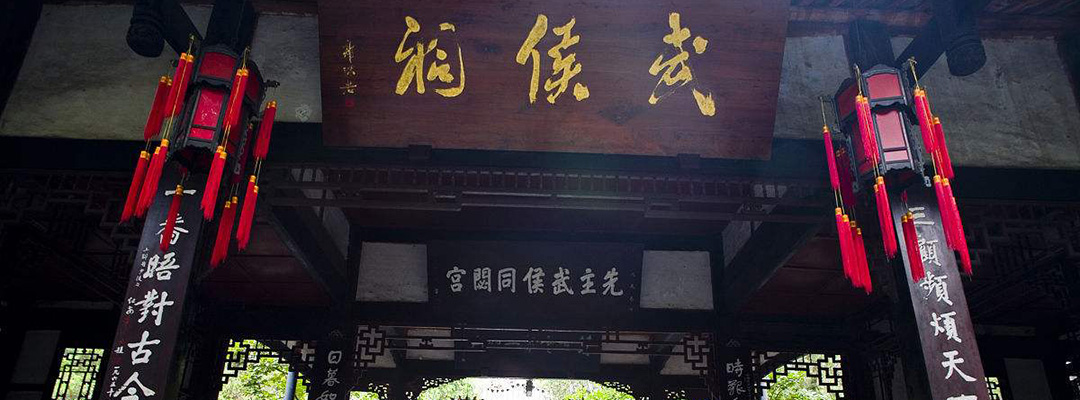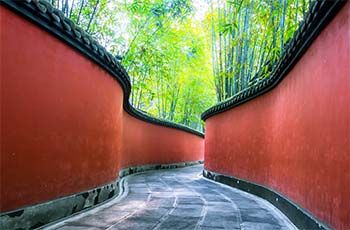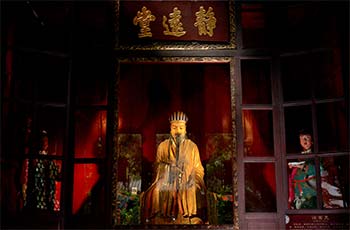Wuhou Memorial Temple

Wuhou Memorial Temple of Chengdu on Wuhouci Street of Southern Chengdu City in Sichuan Province was first built in 223 AD when the Hui Mausoleum of Liu Bei was under construction. As a memorial temple that honors both the monarch and his subjects and the most well-known memorial site in memory of Zhuge Liang, Liu Bei, and other heroes in the Shu-Han Kingdom, Wuhou Memorial Temple is the heritage museum of the Three Kingdoms Period with the most significant influence worldwide. If you are a fan of the Three Kingdoms, then here is an ideal choice that satisfies your curiosity. You’d better come in the early morning when the Temple just opens to the public if you want to be left undisturbed.
- Chinese name: Wǔ Hóu Cí
- Built in 223 AD
- Duration: 2-3 hours
- Entrance fee: RMB 60 for through ticket, RMB 30 for student ticket, 120 for family ticket
- Opening hours: 8:00-21:30 in busy season (July 1st – October 7th); 8:00-18:30 in slack season (October 8th – June 30th next year)
- Address: 231 Wuhouci Street, Chengdu City, Sichuan Province
- Best time to visit: all year around
- How to get there: Take Bus 1, 57, 82, 334, or 335 and get off at Wuhouci Stop; or take Bus 8 or 21 and get off at Wuhouci East Street Stop
Highlights of Wuhou Memorial Temple
- Sanjue Stele: Six steles with high value as cultural relics can be found after you pass through the main entrance. Postcards of Wuhou Memorial Temple are available for free at the ticket office. There is a stele of the Ming Dynasty on the left and one from the Tang Dynasty on the right, with the latter known as Sanjue Stele. The information on this stele was prepared by Pei Du, prime minister in the Tang Dynasty, with characters on it written by calligrapher Liu Gongchuo (elder brother of Liu Gongquan) and inscribed by stonemason Lu Jian. Pei excelled in articles, Liu in calligraphy and Lu in inscription, thus making the stele to be known as “Sanjue Stele”.
- Hui Mausoleum: Tomb of Liu Bei, known as Hui Mausoleum, is in the west of the Hall of Zhuge Liang. The site was chosen by Zhuge Liang. Two wives of Liu Bei were also buried here. Shaped in a circle with a perimeter of 180 m, the tall and solemn Mausoleum surrounded by green pines and verdant cypresses was neither robbed nor excavated. The divine path leading along the front of the Mausoleum was built in the Qing Dynasty. Like the main buildings in Wuhou Memorial Temple, Hui Mausoleum in the west of the Temple faces the south and connects with the Temple by a passageway with red walls. The scene of bamboo shadows against red walls here is worth photo-taking.
- Liu Bei Hall: The Hall consists of the main hall, side halls and side rooms. Statues of Liu Bei and his grandson Liu Chen are in the main hall, statues of Guan Yu and his son and followers in the east side hall, and statues of Zhang Fei and his sons and grandsons in the west side hall.
- Hall of Zhuge Liang: Statue of Zhuge Liang, the resourceful prime minister of the Kingdom of Shu-Han, is in the middle of the shrine. Wearing a silk head dress resembling a ridged roof and golden robe, he is in deep reflection with a feather fan in his hand, presenting a contemplative and gentle image.
- Sanyi Temple: This Temple was built in memory of Liu Bei, Guan Yu and Zhang Fei. Statues of them are true with their images in people’s mind: gentle Liu Bei, loyal Guan Yu, and righteous but blunt Zhang Fei. There is a mock site where they swore to become brothers.
 The scene of bamboo shadows against red walls
The scene of bamboo shadows against red walls  The statue of Zhuge Liang
The statue of Zhuge Liang You would do best to hire a guide who can share historic stories or anecdotes, which may otherwise be missed.
Drop us a line and we'll connect you with the top China expert in no time!